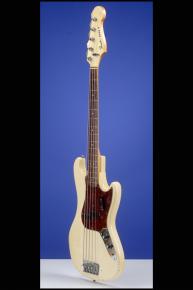One of the First Fender Bass V's
This rare early example weighs 9.80 lbs. and has a nut width of just under 1 3/4 inches and a full bass scale length of 34 inches. Offset asymmetrical double cutaway solid alder body, contoured on back and lower bass bout, one-piece maple neck, and veneer rosewood fretboard with 15 frets and pearloid dot position markers. Headstock decal with "Fender BASS V" logo in gold with black trim, with five patent numbers in black below it and "Offset Contour Body" on the ball of the headstock. Triple string tree. Individual Fender bass tuners with cloverleaf-shaped metal buttons. Four-bolt neck plate with large Fender backward "F" logo in the center and serial number "600073" stamped between the top two screws. One split black five-polepiece pickup with a great, fat pickup output of 10.81k. Four-layer (tortoiseshell over white/black/white) plastic pickguard. Thumbrest on the bass side of the pickguard. Two controls (one volume, one tone) and jack socket, all on metal plate adjoining pickguard. Black plastic conical knobs with ribbed sides. The potentiometers are stamped "304 6542" (Stackpole October 1965). Five-saddle bridge/tailpiece. The back of this very rare custom color guitar looks as if it was stored for a long time against some "pocketed" foam which has caused some discoloration. There is also some finish checking and a few small marks on the body as well as a tiny cigarette burn on the face of the headstock by the "E" tuner. The chrome plated bridge and pickup rests have been removed but otherwise this guitar is in totally original and excellent condition. This is one of the earliest examples of the Fender Bass V with an unbound dot-marker fretboard (which was the first five string bass with normal string spacing -- tuned E A D G C) and one of a very few made in a custom color with matching headstock. Housed in a later black hardshell case with black plush lining (9.00).
"By 1961, a few players (most of them converted guitarists) had begun to define a sound and an approach that distinguished the Fender bass from the upright. But the instrument was awaiting its first virtuoso -- the player who would expand the range of creative possibilities and firmly establish the positon of the electric bass in the musical world. He would arrive in the form of an unassuming studio musician working for a fledgling record label in Detroit: James Jamerson. Jamerson was a bass player not a guitarist. After dabbling with the piano as a child, he studied acoustic bass in high school. He was a quick learner, and before long he was playing jazz on the upright and trying to emulate such heroes as Paul Chambers and Ray Brown. Jamerson's ability as a club musician came to the attention of several local producers, including Motown's Berry Gordy, and James began to get calls for session work. Jamerson started to work for Motown in 1959…sometime in 1961, Jamerson began to play a Fender Precision Bass…and in 1965 Jamerson owned a Bass V and may have experimented with it occasionally in the studio" (Jim Roberts, How The Fender Bass Changed the World, pp. 68-71).
Translate:









